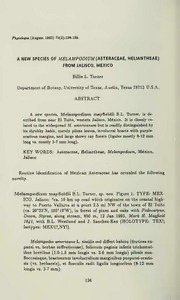
A new species of Melampodium (Asteraceae, Heliantheae) from Jalisco, México PDF
Preview A new species of Melampodium (Asteraceae, Heliantheae) from Jalisco, México
Phyiologia(August 1993)76(2):136-139. ANEWSPECIES OF MELAMPODIUM{ASTEHACEAE, HELIANTHEAE) FROMJALISCO, MEXICO BillieL. Turner DepartmentofBotany,UniversityofTexas, Austin,Texas 78713 U.S.A. ABSTRACT A new species, Melatnpodium mayfleldii B.L. Turner, is de- scribed fromnear El Tuito, westernJalisco, Mexico. It is closely re- latedtothewidespreadM. americanumbutisreadilydistinguishedby its shrubby habit,merelypiloseleaves,involucralbracts withpurple- mm scariousmargins,andlargeshowyrayflorets(ligulesmostly8-12 mm longvs.mostly3-7 long). KEY WORDS: Asteraceae, Heliantheae, Melampodium, Mexico, Jalisco Routine identification of Mexican Asteraceae has revealed the following novelty. Melampodium mayfleldiiB.L. Turner, sp. nov. Figure 1. TYPE: MEX- ICO. Jalisco: "ca. 10 kmup roadwhichoriginatesonthecoastal high- way to Puerto Vallarta at a point 2.5 mi NW ofthe town of El Tuito (ca. 20°23'N, 105°16'W), in forest ofpines and oaks with Podocarpua, Dioon, Styrax, along stream, 850 m, 12 Jan 1993, Mark H. Mayfield 1641, with B.L. Westlund and J. Sanchez-Ken (HOLOTYPE: TEX!; Isotypes: MEXU!,NY!). MelampodioamericanoL.similisseddifferthabitu(fruticesex- pansi vs. herbaesuffruticosae), foliorumpaginis inferistrichomat- ibus brevibus (1.0-1.5 mm longis vs. 3-6 mm longis) pilosis non- floccosisque,bracteoruminvolucraliummarginibuspurpurei-scario- mm sis (vs. herbaceis), et flosculis radii ligulis longioribus (8-12 longis vs. 3-7 mm). NewMelampodiumfrom Mexico 137 Turner: Figure 1, Photograph ofholotypeof Melampodium mayfieldii PHYTOLOGIA 138 volume 75(2):136-139 August 1993 Small spreading shrubs to 50 cm high and ca. as wide. Stems woody, persistent, new annual growth arising from well-defined woody shoots 10-30 cm above the ground-level, the young shoots densely pilose. Leaves simple throughout, sessile or nearly so, the blade epetiolate or passing into an in- distinct petiole, coAuate, oblanceolate, mostly 3-4 cm long, 0.8-1.2 cm wide, mm denselyandevenlywhite-pilosebeneath withincurvedhairs 1.0-1.5 long (these nojt at all elongate, silky and entangled as in Melampodium ameri- canum), the upper surfaces similMly pubescent but less so. Heads 2-3 cm wide across theexpanded rays, single, terminal,on peduncles mostly 3-7 cm long. Principal involucral bracts 5, broadly.obovate, somewhat cuspidate, theapicalmarginsclearlypurple-scarious. Rayflorets 8-13, theligulesbright yellow, 8-12 mm long, 3-5 mm wide. Receptacular bracts with broadly ex- panded, 2-3 lobed yellow-scarious apices. Disk florets numerous, sterile, the corollas yellow. Achenes ca. 3 mmlong, 1.5 mm wide, laterally ornate with 3-4wartyribs,theenclosingbract not producingahood. Onfirst inspection I took the present material to be an unusually suffru- ticosecollectionofthewidespreadhighlyvariable Melampodium americanum L. CloserinspectionrevealedanumberoffeaturesthatreadilydistinguishM. mayfieldiifromthelatter,includingthefollowing: 1) shrubbyhabit,anynew growtharisingfrom woody stems wellabovethegroundlevel(vs. herbs with newannualgrowthfromgroundlevel);2)relativelythick,broad,simpleleaves whichareuniformly pilosebeneath with recurved,short hairs mostly 1.0-1.5 mm mm long (vs. long, silky, silvery-whitehairs 3-6 long); 3) larger involu- cral bracts with well-defined purple-scarious apical margins (vs. herbaceous throughout);and4)ligulesofrayfloretsmostly8-12 mmlong(vs.mostly3-7 mm long). Neither Stuessy's (1972) revisionary treatment of Melampodiumnor Mc- Vaugh's (1984) floristic portrayal of that genus for Jalisco will account for thepresent taxon. In theformer, it will keyto M. linearilobumDC. (an an- nual having involucral bracts with yellow-scarious margins); in the latter it willnot keybecauseofits non flocculent pubescenceon theundersurfaces of leaves, but ifthis character were denied, it would also key with difficulty to M. linearilobum. It is a pleasure to name this species for Mr. Mark H. Mayfield, terminal year doctoral student at the UniversityofTexas, Austin, whois preparing a monographic study of the genus Poinsettia (Euphorbiaceae). He called my attentiontothematerialconcernedandparticipatedinitsdiscovery. ACKNOWLEDGMENTS IamgratefultoGuyNesomfortheLatindiagnosis,andtohimandJacque- lineSouleforreviewingthemanuscript. Turner; NewMelampodiumfrom Mexico 139 LITERATURE CITED McVaugh,R, 1984. Melampodium,inFloraNovo-Gahciana12:585-600. Uni- versityofMichiganPress, Ann Arbor,Michigaa. Stuessy, T.F. 1972. Revisionofthe genus Melampodium(Compositae, He- liantheae). Rhodora 74:1-70; 161-219.
